
views
- Trim the bamboo stems down to the ground and wait for them to regrow to 3 ft (91 cm) high. Then, spray a glyphosate herbicide onto the leaves and stems.
- As an alternative, push a shovel 1 ft (30 cm) deep into the soil around the bamboo to locate its rhizomes. Then, simply dig them out of the ground.
- Or, dig into the ground around the bamboo to expose the rhizomes and roots. Then, boil water and pour it directly on the rhizomes and roots.
Removing Bamboo with Herbicides
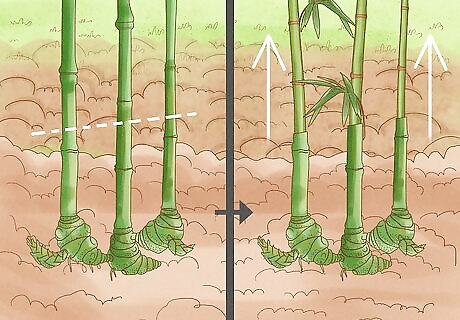
Cut the bamboo to soil level and wait for it to grow 3 feet (91 cm) high. For herbicides to effectively kill bamboo, you have to let your existing bamboo regrow. Just use a saw, machete, or lawn mower to cut the bamboo stems, called culms, down to the ground level. Then, simply wait for it to regrow about 3 feet (91 cm) high, or until the new leaves start to expand. Alternatively, use a lopper to cut back the bamboo. The looper’s large handles often make it easier to cut with than a saw. The best time to get rid of bamboo is when it’s growing in the spring or summer. This speeds up the removal process because you’re applying the herbicide more than once as the bamboo inevitably grows back. Cut the bamboo down in late winter so you have time to apply the herbicide in late spring or early summer.
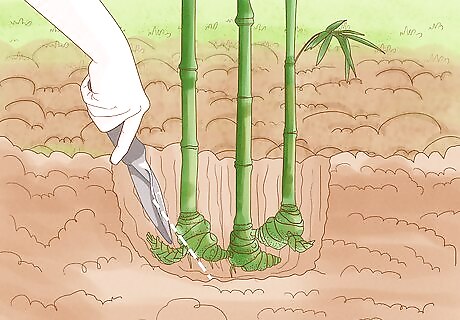
Sever rhizomes with a spade if you want to keep some of the bamboo. Rhizomes are stems that spread under the ground horizontally and are what new bamboo shoots grow from. If you only want to get rid of a specific section of bamboo, break up the rhizomes that connect it to the parent plant so all of your bamboo doesn’t die. Just use a sharp spade or shovel and push it into the soil around the bamboo that you want to get rid of. Rhizomes are buried about 1 foot (30 cm) under the ground. Keep pushing your spade into the ground until you form a perimeter around the section you want to kill. You’ll probably recognize rhizomes if you've ever eaten ginger or galangal, or have seen raw turmeric. These are all rhizomes that look like roots with offshoots growing from them.
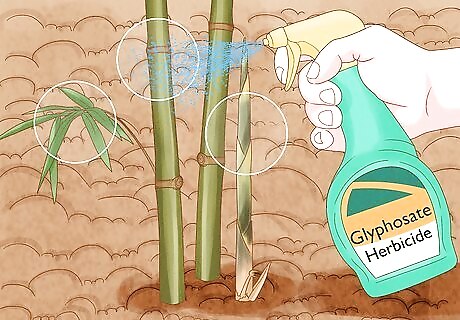
Apply glyphosate herbicide to the stems and leaves of the bamboo. Herbicides that contain the ingredient glyphosate are the most effective at killing bamboo. Simply put on a pair of gloves and spray a glyphosate herbicide onto the leaves, stalks, and shoots of the bamboo. Pick a sunny day to spray so the herbicide has time to penetrate before any rain dilutes it. Glyphosate herbicides only kill the plants that you directly spray it with, so be careful about applying it to just the bamboo. Please note: The World Health Organization (WHO) considers glyphosate to be a probable human carcinogen. Its use is prohibited in some states and countries. Please research your local regulations and conform to them. Always use caution when handling this chemical. When using any kind of herbicide, follow the application instructions that come with the packaging. Some herbicides that contain glyphosate are Roundup Concentrate Plus and Bonide Kleenup Weed & Grass Killer. Paint the herbicide onto the leaves and stalks of the bamboo with a brush to reduce the risk of killing the wrong plant or over-spraying. If your bamboo is near a water supply, like a river, stream, lake, or ocean, use an herbicide that's labeled for use near water. Unless it’s listed in the instructions, do not apply glyphosate herbicide to the soil surrounding the bamboo. This ingredient doesn’t effectively kill bamboo through the soil.
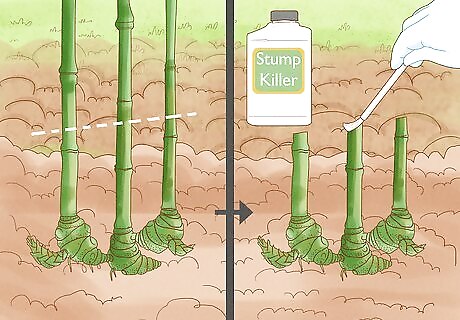
Alternatively, use a stump and root killer on the bamboo. Another way to get rid of bamboo is to cut down the stems and then apply a stump and root killer that contains glyphosate or triclopyr, like Bonide Vine & Stump Killer. Put on a pair of gloves and simply spray the herbicide onto the cut stump and the leaves of any regrowth.

Repeat treatment when the bamboo regrows. Unfortunately, 1 application of herbicide won't eradicate bamboo; this plant is tough and needs multiple treatments to fully get rid of it. Watch for new growth, which can be as quick as a few weeks in the spring and summer. Then, spray the leaves, stalks, and shoots of the plant with your glyphosate herbicide to exterminate it. It often takes 2 to 3 years to completely get rid of the bamboo. Keep rooting out the rhizomes of the bamboo in conjunction with applying herbicides to prevent the bamboo from sending up shoots. Impressively, even wildfires can't completely get rid of bamboo!
Natural Alternatives to Getting Rid of Bamboo
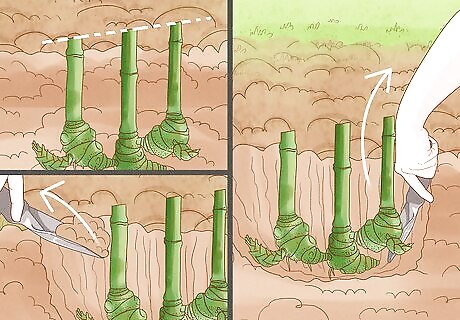
Dig out the bamboo’s rhizomes, repeating as new shoots grow. This is one of the most effective, non-chemical ways to kill your bamboo. Just cut down the stems of the bamboo to the soil level with a saw, machete, or garden clippers. Then, take a shovel or spade and push it about 1 foot (30 cm) deep into the ground around the bamboo. When you hit a rhizome, dig under it and then pull up to loosen it from the ground. Then, simply pull it from the soil with your hands. Digging up the rhizomes once won’t permanently get rid of the bamboo. Pay attention to new growth and continue to dig up the rhizomes; it can take 2 to 3 years of digging to fully kill the bamboo. Pour water onto the soil around the bamboo to loosen up the ground and make digging easier. If you want to keep some of the bamboo, sever the rhizomes of the bamboo you want to kill from the main bamboo plant. For the bamboo to be fully eradicated, you must remove all of the rhizomes. Bamboo shoots can sprout from any leftover rhizomes.
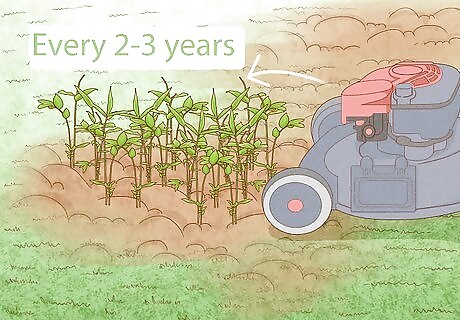
Mow the bamboo to the ground regularly with a lawnmower. Bamboo is a type of grass, and like most grasses, it doesn’t tolerate frequent mowing. If your bamboo is tall, cut it down to the ground with a saw. Then, mow over it with your lawn mower using its lowest setting. Keep mowing the bamboo weekly, or as new growth emerges. It typically takes 2 to 3 years of frequent mowing for the bamboo to die. Mowing the bamboo frequently kills the rhizomes because it removes their way of collecting food from the sun and through the bamboo’s leaves.
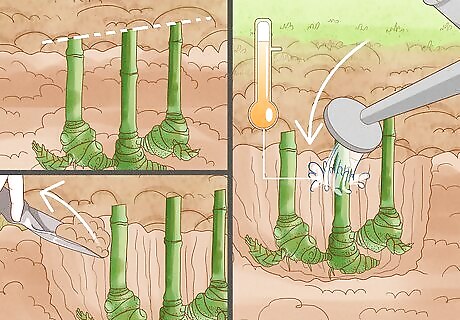
Pour boiling water onto the bamboo’s roots. Boiling water is a natural weed killer that’s effective at killing bamboo, too. Just use a saw to cut any tall bamboo culms, or stems, down to the soil level. Then, dig about 1 foot (30 cm) deep into the soil around the bamboo to find the rhizomes and the roots that grow under them. Boil water on your stove and then pour it directly onto the bamboo’s exposed rhizomes and roots. Continue to dig around the rhizomes and pour water on the roots as new bamboo shoots emerge. Like the other methods, it takes about 2 to 3 years to completely get rid of the bamboo.
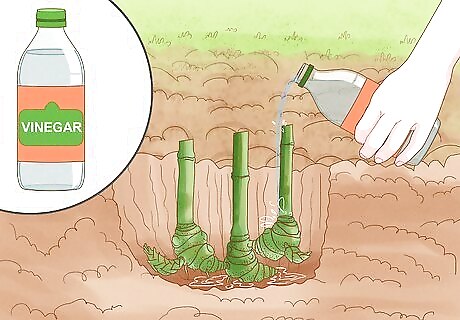
Apply undiluted white vinegar onto the roots of the bamboo. Vinegar contains acetic acid, which is a natural herbicide that dries out a plant’s leaves and stems. If your bamboo stems are tall, trim them down to ground level with a saw, machete, or garden shears. Then, use a shovel or spade to dig up the soil around the bamboo, exposing the rhizomes that are about 1 foot (30 cm) deep in the soil. Put on a pair of gloves and pour the white vinegar directly onto the rhizomes and the roots growing underneath them. When you notice new bamboo shoots growing, dig around the bamboo and pour more vinegar onto the roots. It often takes several applications of vinegar over 2 to 3 years for the bamboo to completely die off. As an alternative, dig out the rhizomes and roots and pour vinegar into the soil. The acidic soil can help prevent new rhizomes from growing.

Cover the bamboo with a tarp to deplete its food source. Another way to get rid of bamboo is to starve it. Start by cutting down the stalks of the bamboo down to the soil line. Then, place a dark, thick tarp or a thick piece of plastic over the top of the stumps. This cuts the bamboo off from the sun, rain, and air, which eventually kills it. Anchor the tarp or plastic down with bricks, cinder blocks, or anything heavy that can withstand the outdoors. This ensures that the tarp doesn’t move and let in air, sun, or water. If you see new growth popping up beyond the perimeter of the tarp, immediately spray it with glyphosate herbicide or cut it down and put another tarp over the area. This method can take a while, so leave the tarp over the stumps for at least a month or so. It can take up to 1 year for the bamboo to completely die.
Keeping Bamboo Contained
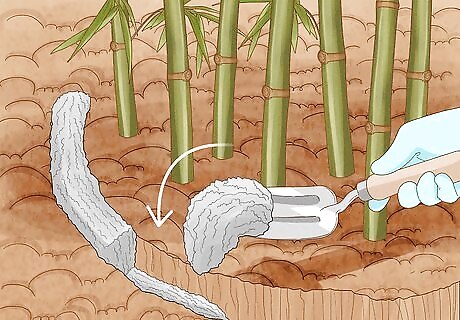
Add a 2-foot (61 cm) deep barrier around one side of the bamboo. If you only want to contain your bamboo on one side of your yard, dig a curved or half-circle trench around your bamboo. Dig the barrier at least 2 to 3 feet (61-91 cm) deep, which is deeper than most rhizomes grow. Then, fill the trench with concrete, 60 mil (1.5 mm) polypropylene fabric, metal sheets, or wood. The benefits of an open-sided barrier are that the bamboo doesn't get too root bound in its enclosed space. It also ensures that the bamboo has adequate drainage. An open-sided barrier is great to set up along a fence or property line, which helps keep your bamboo from escaping into your neighbor's yard (or vice versa). If you’re using a wood barrier, be aware that rhizomes can sometimes travel through wood, especially as it wears down and erodes. If you’re setting up a barrier along a fence, place it directly alongside the fence, with about 2 inches (5.1 cm) of the barrier above the ground. With an open-sided barrier, you need to prune regularly to contain the bamboo.

Dig a trench around the bamboo to fully enclose it as an alternative. Like the open-sided barrier, dig a trench around the entire perimeter of the bamboo that’s at least 2 to 3 feet (61-91 cm) deep. Then, fill the trench with a barrier material like concrete, polypropylene fabric, or metal. Because the bamboo is enclosed all the way around, no rhizomes are likely to escape and spread. Make sure that at least 2 inches (5.1 cm) of the barrier is visible above the ground. This helps you detect when any rhizomes try to escape over the sides. Even though the bamboo is completely contained, regularly check for new shoots sprouting beyond the barrier.
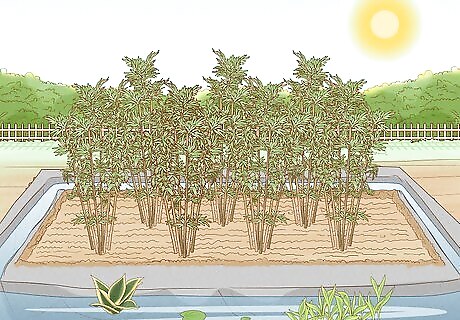
Contain the bamboo on one side with a pond or stream. A pond or stream coupled with a 3-sided trench is a natural, decorative, and effective barrier against the bamboo. To build a pond, dig into the ground about 1.5 to 2 feet (0.5-0.6 m) deep with a shovel or spade. Add a 1-inch (3 cm) layer of builder’s sand into the hole and then cover the entire pond with a pond liner. Then, simply fill it up with water. A pond or stream acts as the fourth wall of the barrier since rhizomes can’t travel across water.

Check the barrier’s perimeter periodically for escaping rhizomes. Your bamboo doesn’t have many places to grow when you contain it with a deep enclosure. Still, bamboo is resilient, so keep a vigilant watch on it to make sure it doesn’t creep out of its designated area. If you do catch some unruly bamboo, remove it entirely. Cut the shoots to the soil level then treat it with herbicides, mow over it, or use any of the other methods mentioned above to remove it.

















Comments
0 comment